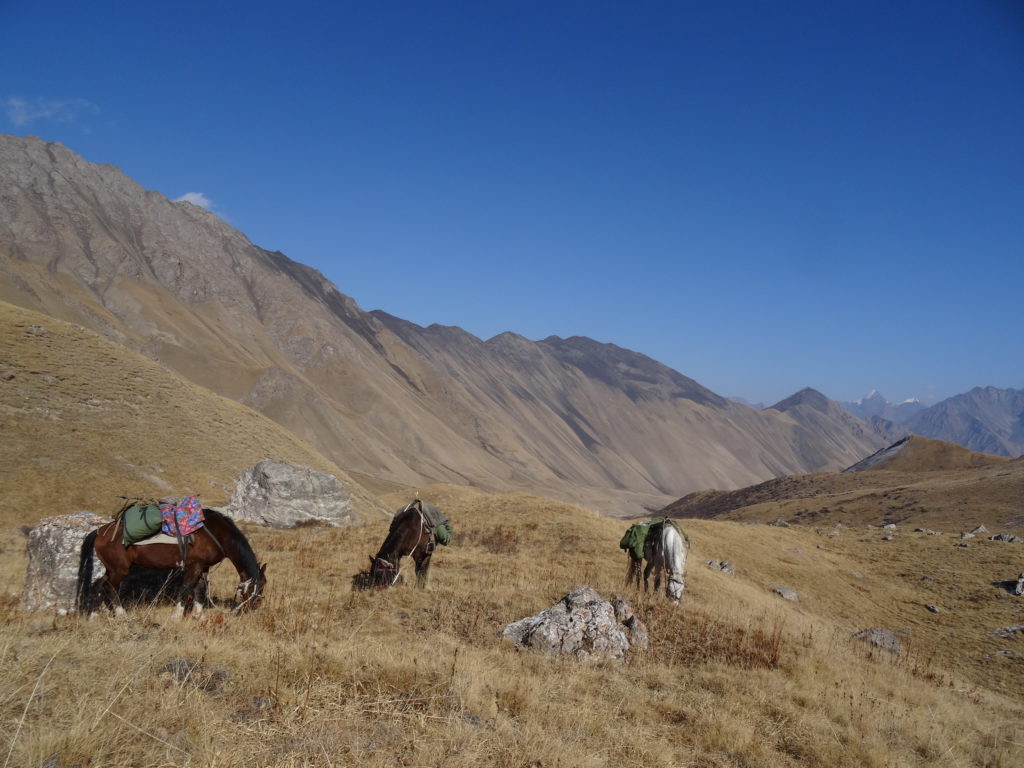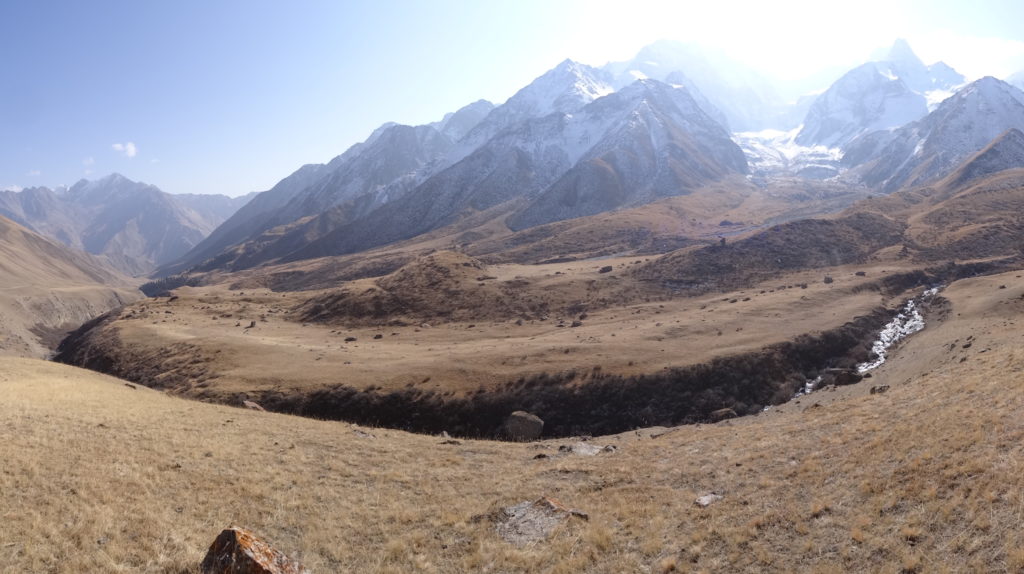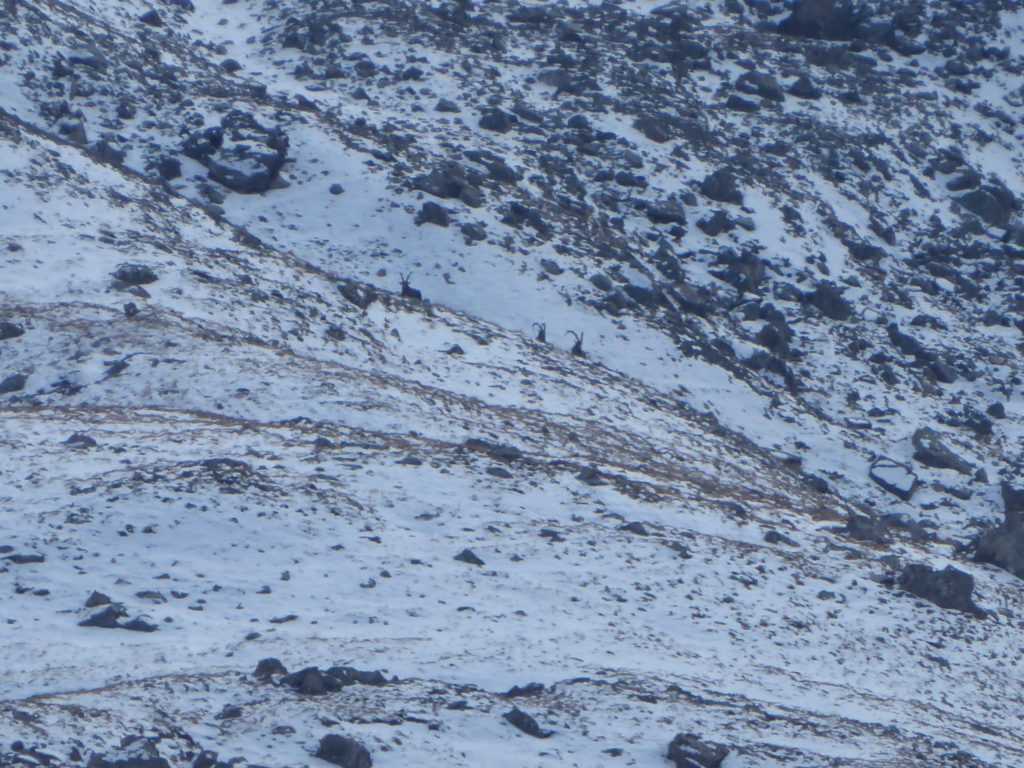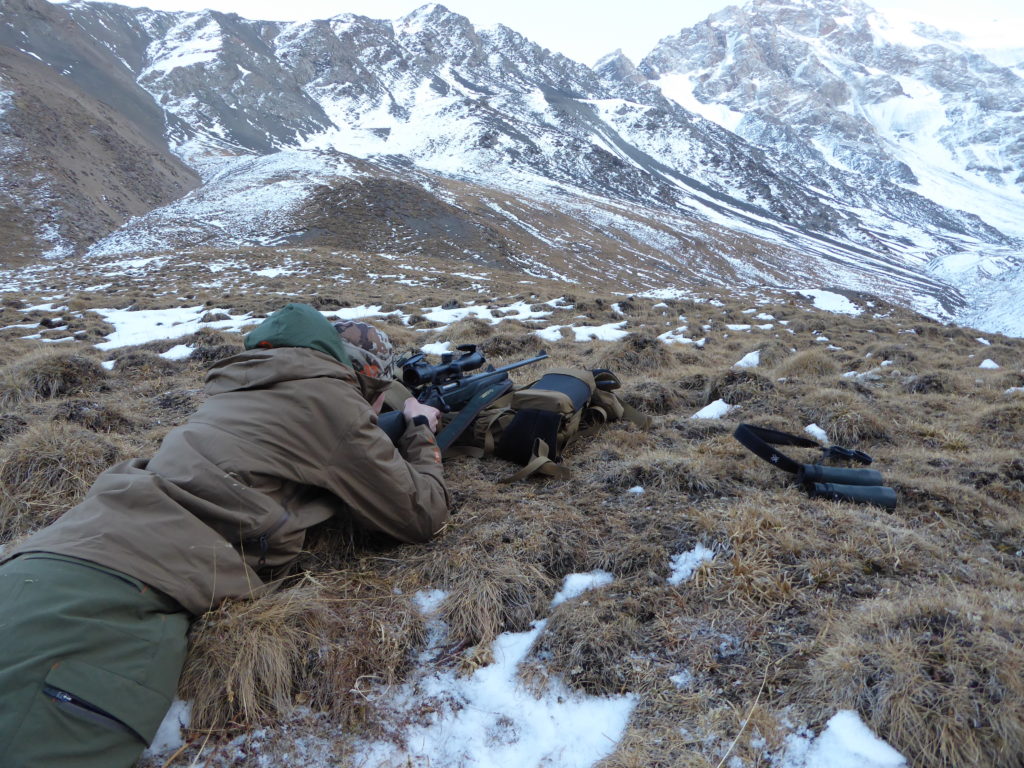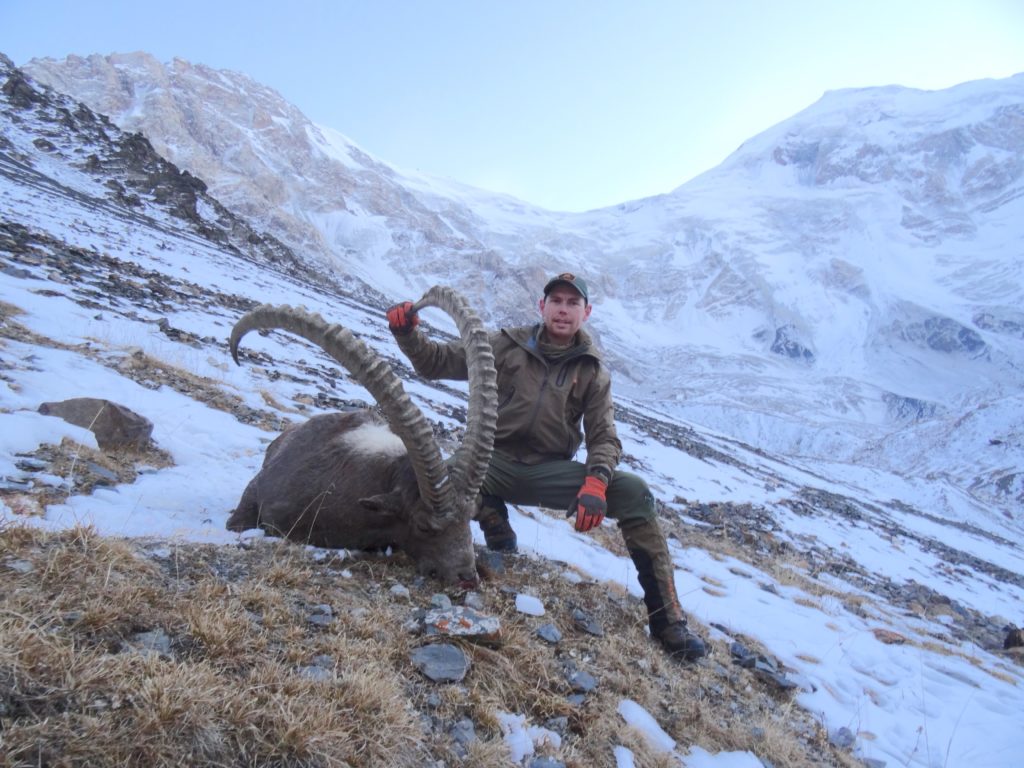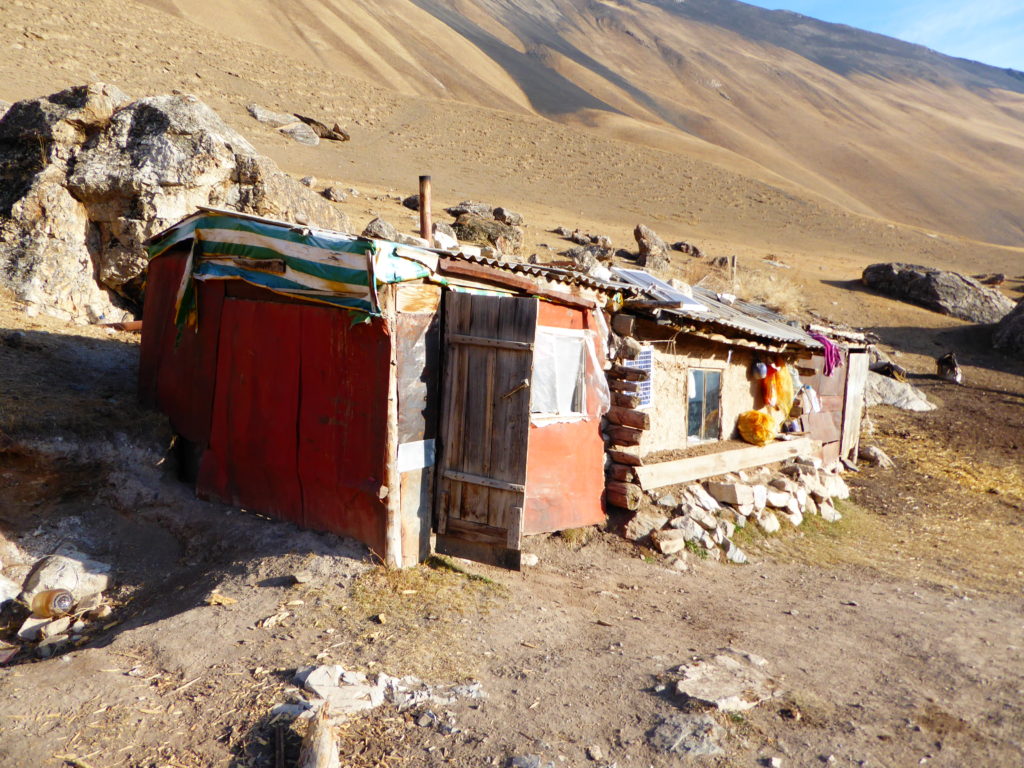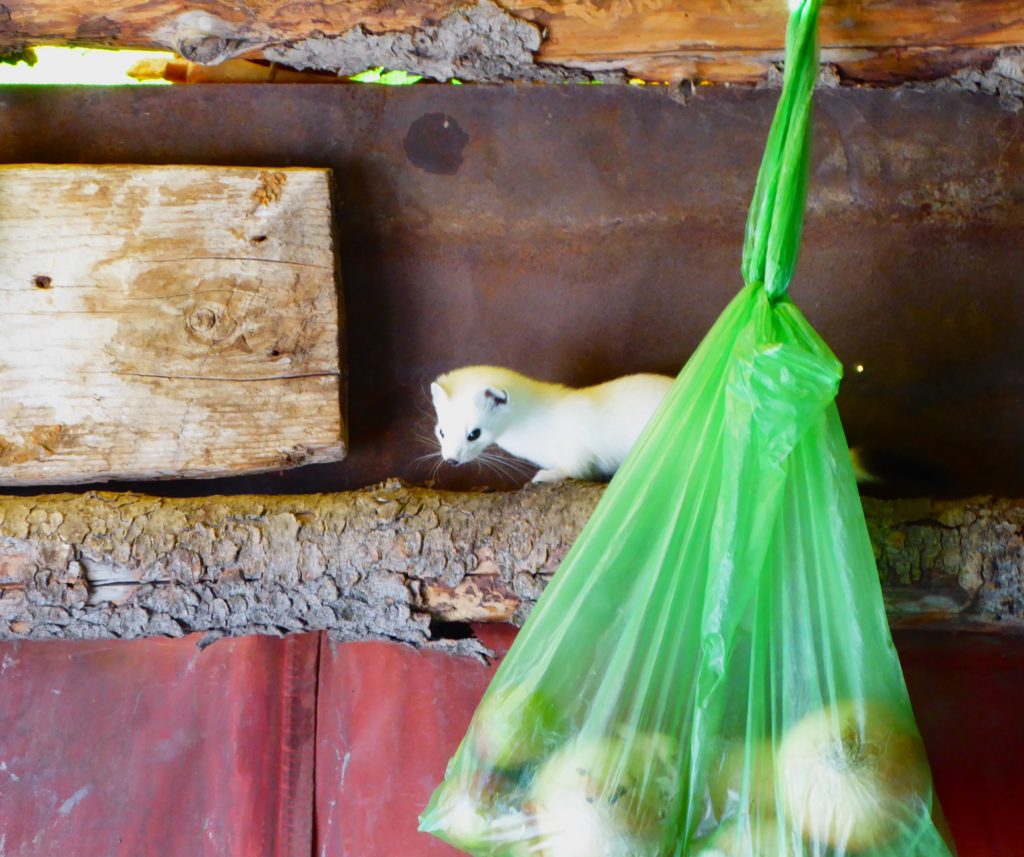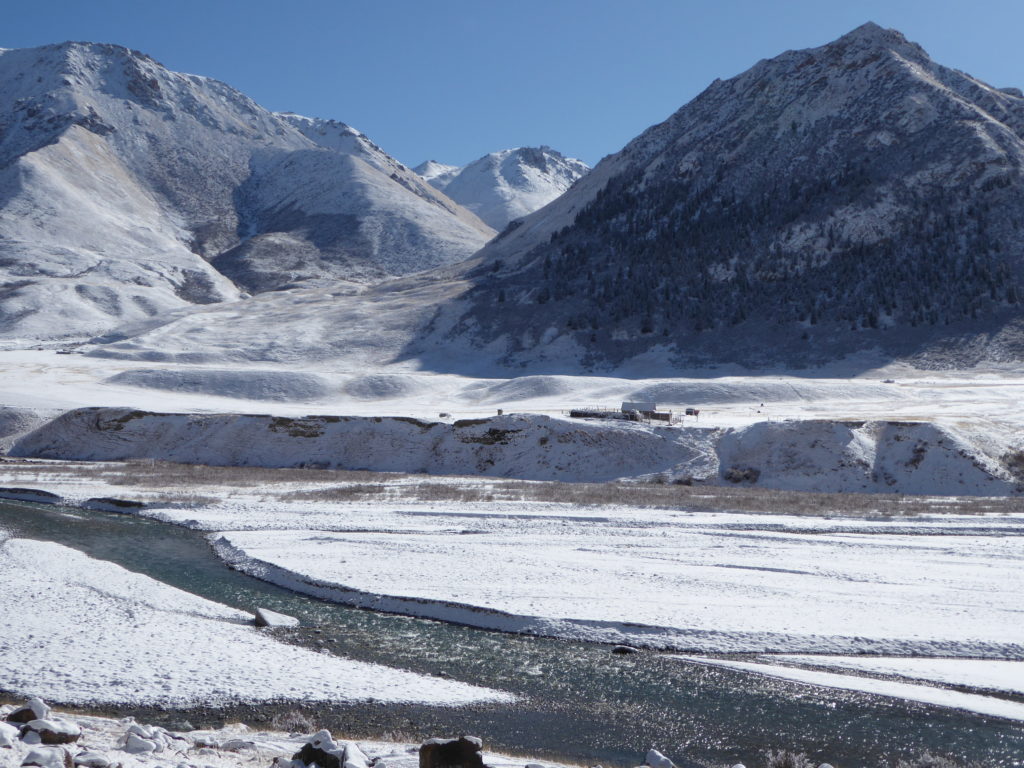We packed our camp and embarked on what would be an eight-hour ride into a vast and rugged valley. As we entered the head of the valley we stopped at a small house where a family of yak farmers lived. This turned out to be my guide Erlan’s home where he and his extended family lived. Their home was a small transportable building that had rooms made of mud with straw walls added to the side. From the home emerged his wife and two young daughters. Erlan smiled as he saw his daughters run from their home. It was clear that I was an unfamiliar sight to the family who would stare with relentless curiosity as if to work out what I was.
The ride up into the valley took us through herds of yaks to the desolate rocky land beyond the arable valley floor. On the fringe of the grazing land lay the carcasses of several calves killed by wolves. The wolves are persecuted by locals whose marginal livelihood they threaten. Thankfully snow leopards predominantly target ibex and are highly elusive, otherwise, I suspect they might also be targeted. There is a lot to be said for well-regulated hunting programs that incentivize local people to maintain and coexist with wildlife. The populations of ibex in this area, a potential competitor for feed, are a testament to this.
Nearing the junction of three massive glacial valleys, a trio of red foxes bounded amongst the low grass, hunting small prey. On horseback we were able to approach to within 100m before they spooked, appearing almost to fly with their feet only momentarily touching the ground.
We neared a frozen creek where we dismounted the horses before crossing. The horses approached frozen creeks with extreme reluctance and took considerable encouragement to cross. It was now mid-afternoon, and we lay down to glass the incredible vista and have some lunch.
Being at the head of the valley there was a clear elevation at which vegetation ceased to exist and true alpine began. Beyond this line lay some of the most rugged and awesome mountain terrain I’ve ever laid eyes on. Crowning the uppermost reaches of the valley was a near vertical basin of rock chiselled out by the glacial forces over millennia. Remnants of these glaciers clung precariously to the valley walls with aqua blue faces revealing where they had calved off into the moraine deposits below. Snow falls would come and go with the rapidly changing weather formations around the towering peaks.
As I lay against my pack glassing the crags above, I paused to appreciate the surroundings and thought to myself that it would be incredible to take an ibex in the head of that valley – the location itself would make the trip.
As the afternoon wound on family groups of ibex began to appear. Each new spotting would raise a moment of hope which was quickly hosed down by Erlan’s swift and unanimated assessment of ‘baby mama’. This went on all afternoon with probably a dozen separate groups spotted. The guides began to lose interest in glassing and their body language indicated that they had seen all there was in this valley. Having travelled so far and with only a few hours of daylight left, there was no time to relocate. The day appeared to be shaping up the same as the previous.
After picking apart the landscape multiple times I started to contemplate what would become of the hunt and where we would go from here. I thought about how many days were left to hunt, the time it would take to get back to base camp and the cold front that was forecast. My decision to pass a mature billy on day one was playing on my mind. In an almost desperate attempt, I glassed back into the huge glacial basin that I’d earlier dreamed of hunting in and, as if to appear from nowhere, perched atop a moraine pile were three billies. It was immediately obvious that two of these billies were good animals. I took a moment to locate some notable features around them before calling to the guides to take a look.
Chubak, with binos glued to his face, quietly said something to Erlan. Moving calmly but purposefully, Erlan set up the spotting scope and carefully assessed the ibex. He held up five fingers, indicating that there are two more that I’d not yet seen. After assessing each of the ibex through the spotting scope it was obvious that there were two old billies and three less mature animals in the 39-43” range. Of the two large billies, one was narrow and long and the other wide and a few inches shorter. Both uniquely impressive animals.
Their position was protected from above by the vertical walls of the basin and offered excellent views to detect predators approaching from below. It was nearly unapproachable for shots within my comfortable shooting range of 400m and an attempted stalk would likely mean spooking them. We would have to wait for them to move and hope that they would feed into a more favourable position. It seemed logical that they would feed down into the valley below the snow line, but this offered only one source of cover being a narrow drainage line at the foot of the far rock face.
After what seemed like an age, one by one, they stood up and began to feed. With dark approaching and over 1.5km between our location and theirs, we would have to move quickly. Erlan and I left Chubak with the horses and dropped back down the valley into the drainage line to stay out of sight. The drainage line was deep and provided good cover but eventually it opened up as we approached the base of the moraine piles. We hugged the toe of a steep hill and as we rounded the corner we watched carefully for the ibex. They were still around 800m away, but we could not risk spooking them. Suddenly, Erlan laid back into the hillside and shuffled backwards motioning for me to do the same. One of the small billies had sat back down and was overlooking our position. We were pinned.
Unable to see the other ibex, we could only hope that the young billy would get up and join them again. Every few minutes we would peak around the face to observe the billy. The cold air was moving down the valley and was perfect for the stalk. If we couldn’t get into position before dark, we would have to back out carefully and hope they would still be here tomorrow. The young billy eventually stood up and joined the rest of the ibex, which had dropped behind a small rise. This allowed us to move but as we rounded the small face we were met with a featureless, open hillside of some 100m before reaching the cover of the next moraine. Erlan looked back as if to say ‘are you ready for this?’ and then broke into a sprint with knees bent and folded at the waist. I followed and was shortly out of breath. We were approaching some of the highest altitudes I’d experienced on this hunt and I simply could not get enough oxygen. About halfway through the sprint my lungs and throat literally burned, and my legs were almost giving way. Stopping in the open was not an option and would certainly result in spooking the ibex. My eyes watered, saliva ran from my mouth uncontrollably and I was on the brink of physically being sick as I collapsed into the cover of the rubble pile. It wasn’t pretty, but I had made it across. I lay back into my pack and rested for a few moments before Erlan motioned to climb up over the top to see where the ibex were.
If all had gone to plan they should have fed to within 150m of our location but as we crested the rise the ibex were not on the bench that we’d expected. They had fed up the valley wall and looked to be heading almost directly up the face. The gap between us and them was slowly increasing and with no way to move closer, it was now or never. Resting my rifle over my pack, I lay into the grass and snow and position myself behind the scope.
The ibex were dropping in and out of view behind a small rise which I had ranged at 360m. They fed in a random pattern with their order constantly changing making it hard to keep track of the two mature billies amongst the group. The pressure was mounting as their distance increased. As the group fed onto my side of the small rise I quickly ranged them at 402m. I looked to Erlan to try and confirm that I was looking at the correct ibex and he just kept saying ‘shoot’ ‘shoot’. I quickly surveyed the group again, dialled my turret for 400m, trained my scope on the shoulder of the largest billy. Focus, relax, breathe, squeeze. The Sauer 300WM barked, sending the Barnes TTSX on its way. In the recoil, I saw the billy drop emphatically. I quickly reloaded but Erlan’s smile and animation told me this wasn’t necessary.
I rolled over and lay into my pack and just let the moment sink in. It was a mix of relief, excitement, pride and exhaustion. It was a surreal moment after the lead up to the hunt and made even more incredible against this spectacular backdrop.
We made our way up to where the billy lay. He had rolled downhill a small way and settled on a patch of snow. As I approached, the true size of this animal dawned on me. Not just the horns but the sheer size of the body which was only made to appear even more massive with the thick chocolate coloured winter coat.

After the obligatory photos, we caped out the animal. Caping was brutal with nighttime temperatures in the high basin falling rapidly. Our fingers ached as we took turns on the knife, removing the cape and internals. At this stage, only the high-value meat was recovered including the heart, caul fat, kidneys and liver. It was pitch black and getting dangerously cold. We needed to get off the mountain. We lay some items of clothing around the carcass to keep wolves and snow leopards off through the night and carried the hide and some meat to the waiting horses that Chubak had worked into the base of the hillside.
To my surprise, rather than making camp, we were to ride back down the valley. An almost full moon was rising but its light had not yet spilled down to our side of the valley leaving us with zero visibility. Thankfully the horses were able to navigate the myriad of marmot holes that littered the landscape. As we rode silently into the night I glanced back to the high basin. The brilliant moonlight had illuminated it like a great cathedral of snow, rock and ice – a truly breathtaking sight.
We rode for over an hour and made it back to a small shepherd’s hut where we would sleep the night. Despite the cold, the guides didn’t see fit to fire up the dung stove and we again dined on noodles and tinned beef. It was a much lighter mood this night and we laughed as we tried to communicate and understand each other’s lives. Using the Google Translate App we were able to translate between Russian and English. This was still difficult as only Chubak could read some Russian and he would then discuss with Erlan. I showed Erlan Facebook, asking if he uses it. He looked back blankly and indicated that he did not know what it was. Our translation session ended abruptly when the phone battery died in the cold conditions.
Through the night I could hear something scampering around the hut. Chubak insisted it was a ‘moose’ and didn’t let it affect his sleep. It was running along the inside of the roof, along the wall inches from my head and, at one stage, in an aluminum teapot. Despite my attempts to spot this thing with my head torch it evaded my vision and remained unseen until morning where it was revealed to be a beautiful white weasel-like animal. The guides called it a ‘horrace’ which I later discovered is an ermine or stoat.
Working at a much slower pace the following morning, we headed back up the mountain to recover the meat. Such is the insulating properties of the ibex hide, the carcass had frozen solid everywhere except where the hide remained on the back legs. The guides used a most unusual butchering technique whereby they scored the inside of the ribs until they were able to snap them backwards and remove them as a single massive rack. Almost none of the typical cuts were left in-tact using this method. For example, the backstrap was sliced in half longways, completely ruining it as a single muscle but highlighting how different cuts of meat are viewed by our cultures.
We loaded all our gear and made for Erlan’s house. Much of the meat would be shared with his extended family, many of whom were present when we arrived. The women kept a low profile and tended to the meat while the men had gathered to do some work with the yaks in a yard adjacent to the house. Yaks don’t appear to be fully domesticated like cattle and are remarkably strong and wild. They were being forced into a timber race where they would be administered an injection. One particularly stubborn yak was having none of that which caused much frustration for the men. Erlan jumped into the yard and attempted to wrestle the yak to the ground by the neck but couldn’t overpower the beast. Eventually, it was lassoed and cranked into a post where it was held for its injection.
As I watched the yak wrangling from the side of the yards, an old man approached me, pointing at my sunglasses. I handed them to him and he put them on with a smile. He gazed all around, up into the valley, into the sky and down to the river below. It was clearly a new and amazing experience for him.
We took a ride in Erlan’s Lada Niva back to the base camp where we were greeted by the outfitter, one of my mates who had taken an ibex the day prior, and the camp staff. The driver, who also turned out to be the taxidermist, began preparations to boil the skulls, which was done in a large pot of water and peroxide. This was a process that seemed fraught with danger but the result it achieved was remarkable. Within an hour the skull had no traces of meat or sinew and was completely white. Even the normally immovable black build up on the teeth had become white.
The cape, however, required significant additional work to properly flesh, split the ears, lips and nose and I removed around 1kg of meat over the next few hours. Once properly fleshed it was salted and hung to drain.
The following day the final hunter in our party arrived back at camp with an ibex. The ibex were all fine billies exceeding 9 years of age and 45 inches in length. The other hunters had encountered large groups of mature billies. The billies had not yet split up for the rut and the lack of snowfall had kept them holding high. It is important to match the timing of this hunt with your expectations. Hunting too early season will see a challenging hunt with likely many miles travelled searching for bands of billies. Hunting late season may see the hunt end quickly as animals are concentrated at lower elevations but the risk of significant snow increases. This hunt took place from late October through early November, which provided a good balance between conditions, hunt duration, and hide quality.
Late on the day before we departed a snowstorm blew in with a cold front. Our passage through the mountain pass back to Bishkek was now questionable. The morning greeted us with a magnificent sunny day and a blanket of white over everything. With a good few inches of snow having fallen at the lower elevation base camp, there were murmurs in the camp indicating that we might be staying longer than anticipated. The driver headed off to see if the road was passable. Around lunchtime, he returned to camp and advised that it had just opened. We scrambled our gear and loaded the car for the 12-hour drive back to Bishkek.
The drive home was tiring but there was a sense of unease amongst us hunters. As night fell and we travelled through remote villages and long stretches of potholed highways our driver had become noticeably sleepy. We made efforts to keep his attention on the road, but his judgement was clearly lacking. Indicating to pass a slow truck, the driver edged across to the other side of the road, the Nissan Patrol slowly accelerating. From the back seat, I could see an oncoming cars headlights travelling fast. The situation seemed surreal. We were not going to pass the truck before the car hit us. I braced for impact and at the last moment we veered onto the verge and the oncoming car passed by us, wheels locked and sliding sideways. It regained control and pulled over.
Our driver got out of the car and approached the other vehicle. We looked at each other as if to say, ‘it’s on here’ and quickly put our boots on. What ensued was a short, heated exchange between our driver that was quickly settled with much relief from the occupants of our vehicle. It’s fair to say that the remainder of the trip was awkward and intense.
Back in Bishkek, we took a day to enjoy a few of the local eateries and some shopping before heading to the airport for the long journey home. The departure from the airport was a little less smooth. A baggage handler fleeced a bogus ‘luggage handling fee’ from us before allowing us to board and a failed take-off saw the plane almost run out of airstrip due to the ‘tailgate open’ light coming on. Eventually, we departed and commenced the long trip home complete with a 17-hour layover in Dubai.
The long trip home gave me plenty of opportunities to reflect on the hunt. You really get more than just the hunt in Central Asia and my experience in Kyrgyzstan was truly enjoyable and was a real adventure. There are challenges with hunting in Central Asia, but it offers a true wilderness experience, fantastic hunting and exposure to unique and traditional cultures. The game populations are typically plentiful, and the hunting takes place in some of the most magnificent mountains you could imagine. The simple things like living with the locals, experiencing their food, their history, environment and wildlife are memories that I will treasure. Even if you don’t take an animal, you will certainly grow as a hunter and be better for the experience.



